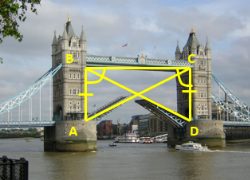Summary
Lesson Website: http://tinyurl.com/causey21 (containing all lesson materials)
As a culminating activity for the first semester, students were given the opportunity to apply real world applications of Geometry as witnessed in everyday objects. Students used a means of self-discovery in order to acquire ten different images. Students were instructed, but not limited to, using digital tools such as Google Maps, Google Images, Google Earth, or by going out and taking their own photos with their digital camera or smartphone in order to acquire these images. Once these real world images were obtained, student had to use critical thinking in order to develop ten unique Geometry problems for their classmates to solve. Student artifacts containing the images, annotations, and student created math problems were prominently displayed on their very own student created website.
TIPC Ratings
Developing – the school ITRT modeled ways in which students could use Google Earth or Google Maps in order to acquire images. (Students were also given the opportunity to use their own digital camera if they chose to do so.) Students then chose the most appropriate digital tools available to them in order to complete the project. Students found the images that they wanted to use and developed the Geometry questions related to each image.
Upper Developing– students did not work together on this project. However, they did communicate their project with each other by sharing their websites and then viewing each others’ websites. In addition, because each website was public, student projects were viewed by others around the world. (One student even shared this project with a family member in Dubai, and now the Geometry class at her school is completing the same project!) Two students also shared their student artifacts during the February faculty meeting during the highlight on instruction segment.
Ideal/Target – This project was completely focused on students choosing their own digital images and then creating their own authentic Geometry problem around each image. Students were the ones creating the questions, not the teacher. Students had to use what they had learned in class and apply it to the real world in order to come up with meaningful Geometry problems for their classmates to solve. After the project, students were given the opportunity to reflect on how this project would help to improve future work that they do.
Ideal – The teacher created an environment in which students could creatively come up with their own unique Geometry problems and then share these with classmates. Students had to create their own authentic tasks by applying the Geometry concepts that they had learned. All projects were unique and original. Upon reflection, students often reported that the most challenging part of this project was to come up with creative, insightful Geometry problems.






